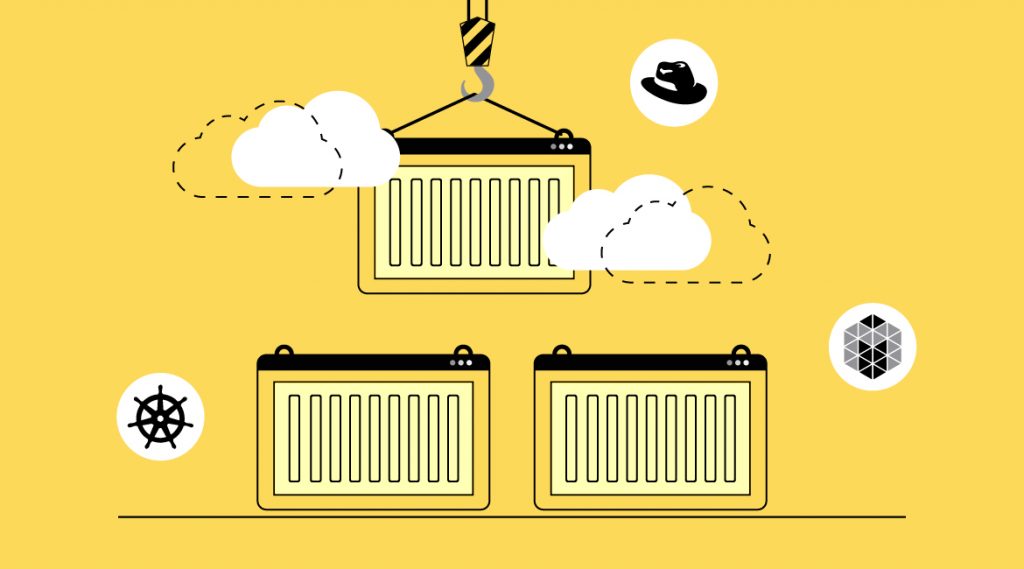Contents
Container orchestration tools are software solutions for web app management used during the development, testing, and deployment stages. Let’s take a look at the basic concepts of container orchestration processes and discover the best containerization solutions for their implementation.
Microservices and modular design are becoming extremely common as companies want more nimble and portable applications. Containers, which allow developers to package up infrastructure components into isolated units, have been a game changer. They can spin up lightning-fast across all kinds of environments.
But most large apps involve dozens or even hundreds of containers working together. Trying to manually coordinate many moving parts quickly becomes overwhelming, even for experienced DevOps engineers.
That’s why containerization solutions are so valuable. They handle critical but tedious tasks like monitoring, scaling, and load balancing behind the scenes. But with so many orchestrators to choose from, how do you pick the right one? In this article, we’ll explore the most popular options available today and provide a container orchestration comparison.
What Is Container Orchestration Tool?

A container orchestration platform is software that helps manage, scale, and maintain containers across clusters of hosts. Container platforms like Docker are often used for microservice-based apps packaging (containerization).
With the growing number of containers, the management process becomes more difficult. Container orchestration solves this problem by automating deployment, scaling, load balancing, and networking.
The main container orchestration benefits are:
- easy deployment and management;
- adaptability and portability;
- stable OS resource virtualization;
- equable load balancing ability;
- high scalability.
Deployment and scaling
Load balancing
Health monitoring
Service discovery and networking
Deployment Strategies Used by Container Orchestration Tools

Let’s take a look at the basic strategies for container orchestration:
- recreate: version A is terminated and version B is rolled out;
- ramped (also known as rolling-update or incremental): version B is gradually rolled out and replaces version A;
- blue/green: versions A and B are released simultaneously, then the traffic is redirected to version B;
- canary: version B is released to a subset of users, then you proceed to a full rollout;
- a / b testing: version B is released to a subset of users under specific conditions;
- shadow: version B receives real traffic alongside version A and doesn’t impact the response.
Container Orchestration Tools Comparison
Now let’s take a look at the container orchestration tools list compiled by our experts.
Kubernetes
Kubernetes is probably the best container orchestration tool that offers a wide range of features including automatic load balancing and scaling.
The Kubernetes container orchestration software consists of four main components:
- nodes. In Kubernetes, nodes run containerized workloads and facilitate data exchange. Nodes can be virtual or physical;
- clusters. Clusters are sets of the nodes that consume resources and run containerized apps;
- replication controllers. Replication controllers are smart agents that schedule and allocate resources between containers;
- shortcuts. Shortcuts are the tags Kubernetes tool uses to identify containers in a module.
Kubernetes platform also offers an extensive function library and gives developers unmatched control over microservices. As a result, it provides great opportunities for building easy-to-manage container orchestration solutions.
Apache Mesos
Mesos is the next cluster management tool that efficiently orchestrates containers. Mesos is open-source container orchestration software that enables resource sharing between distributed frameworks. It provides resource allocation using modern core features such as Zones on Solaris and CGroups on Linux. Mesos also uses the Chronos Scheduler for running and stopping the services, and the Marathon API for services scalability and load balancing.
Key features of the Apache Mesos container orchestration tool are:
- A graphical user interface for monitoring the cluster’s health;
- Linear scalability with 10,000 node deployments;
- LXC isolation between tasks;
- Integration with Zookeeper for fault-tolerant master replication;
- API for new app development in Java, C ++, etc.
Helios
Helios helps developers manage Docker containers by deploying them on distributed servers. Helios is especially popular with developers for its practicality and functionality that enhances CI/CD pipelines.
The platform integrates seamlessly with most DevOps workflows and doesn’t require any specific operating systems, cloud services, or network topologies. As the next benefit, Helios documents the cluster history with event logs such as restarts, deployments, and version changes. It helps developers identify underlying security vulnerabilities, effectively leveraging the HTTP API client or command-line interface.
Key features of Helios are:
- Integrated container orchestration tool in DevOps;
- Can run both single-node and multi-node instances;
- Doesn’t require Apache Mesos usage;
- Provides prescribed load balancers and routers independence.
Best Container Orchestration Tools for Kubernetes
While Kubernetes provides the core orchestration and scheduling capabilities, there are still some container orchestration systems and solutions that aim to augment, extend, or build on top of Kubernetes to provide additional functionality.
Here are a few reasons why additional IT orchestration tools for Kubernetes are helpful:
- Kubernetes alone is quite low-level and close to the infrastructure. The tools provide abstractions that make it easier for developers to deploy and manage applications on Kubernetes.
- They help set up, configure, and operate production-grade Kubernetes clusters, while Kubernetes just defines the cluster architecture and behaviors.
- Tools like Helm simplify packaging and installing apps on Kubernetes.
- Solutions like OpenShift and Mirantis Engine incorporate enterprise capabilities around upstream Kubernetes, such as RBAC, security scanning, CI/CD integration, etc.
Let’s take a look at container orchestration platforms for Kubernetes in more detail.
EKS (AWS), AKS (Azure), GKE (Google)
It is important to review cloud Kubernetes services as well.
Amazon Elastic Kubernetes Service (AWS) can be used in conjunction with Kubernetes. In particular, AWS is equipped with a tool called Elastic Container that serves as a means to run Kubernetes applications within the same cluster.
Azure Kubernetes Service (AKS) provides a serverless Kubernetes platform with built-in continuous integration and continuous delivery capabilities and enterprise-grade security and governance. Bring development and operations teams together on a single platform so you can build, deliver, and scale applications quickly and confidently.
Google Kubernetes Engine (GKE) is a cloud-based managed container orchestration service. GKE Autopilot has two components – the control plane and the work nodes. The management plane is responsible for managing the entire infrastructure of the cluster and the workloads running on it. And nodes run client applications packaged in containers.
Mirantis Kubernetes Engine
Mirantis is a container orchestrator tool that helps to manage Kubernetes and Docker Swarms clusters with maximum flexibility. Mirantis offers multi-layered security including role-based access control (RBAC). With node-based isolation, this tool also forms an efficient multi-tenant architecture with clear resource sharing.
Mirantis uses Calico for Kubernetes networks and includes Istio Ingress to improve load balancing and provide optimized gateway management. This tool also helps to submit code faster and provides an easy experience on major cloud platforms.
The key features of Mirantis Kubernetes Engine are:
- simplified container management with standard assemblies patterns usage;
- high-level security provided with independent apps running in different containers;
- app portability to various platforms;
- continuous-integration for faster deployment with Mirantis Drivetrain.
With this solution, organizations can scale and modernize apps using the Drivetrain lifecycle management system. This tool integrates with the Mirantis Cloud platform to regularly update and improve open-source software. The Mirantis Drivetrain Lifecycle enables a DevOps development approach and provides a continuous delivery pipeline.
Platform9 Managed Kubernetes
Platform9 Managed Kubernetes (PMK) is one of the most popular enterprise-grade Kubernetes offerings designed to manage the full lifecycle of “Kubernetes-as-a-Service.” PMK takes the flexibility and power of open-source Kubernetes and wraps it into a fully managed and secured software-as-a-service solution.
Platform9 aims to simplify how businesses orchestrate containers across complex multi-cloud environments. PMK handles the heavy lifting on infrastructure and DevOps, so engineering teams don’t have to become full-blown Kubernetes experts just to begin containerizing applications.
Here are some of the key capabilities provided by Platform9 Managed Kubernetes:
- Multi-cluster support. The solution allows you to centrally administer multiple clusters across on-premise, private cloud, or public clouds like AWS, Azure, and GCP.
- One-click cluster creation. You can get dedicated Kubernetes clusters up and running in under 20 minutes with a few clicks. The platform also supports major IaaS provisioning.
- Kubernetes upgrades included. Regular, production-safe upgrades are provided across the PMK cluster fleet to keep customers current.
- Role-based policies across clusters. You can define consistent, fine-grained access controls across teams and namespaces in the PMK domain.
- Integrated security. The platform incorporates best practices, including complete pod security hardening, CVE tracking and alerts, runtime threat scanning using Twistock, and firewall integration.
Red Hat OpenShift
OpenShift provides an enterprise-grade hybrid platform that extends Kubernetes functionality for companies looking for managed orchestration. The platform is built on an enterprise-grade Linux operating system that automates the containerized app lifecycle.
This tool provides easy management of all the workloads using a container to virtualize each host. Moreover, with the help of templates and ready-made images, OpenShift simplifies the usage of databases, frameworks, and so on. The result is a highly optimized platform that standardizes manufacturing workflows, enables continuous integration, and helps companies to automate app services management.
On the Red Hat Marketplace, you can also purchase certified apps in different niches, such as billing, transparency, governance, and operational support.
Key features of Red Hat OpenShift:
- built-in Jenkins pipelines streamline workflows, speeding up production;
- comes with embedded container runtime (CoreOS), but also can be integrated with the standard CRI-O and Docker runtimes;
- supports SDN and tests integration with various network solutions;
- can be integrated with various development and operational tools for self-service containers;
- has the Embedded Operator Hub that gives administrators easy access to services such as Kubernetes operators, third-party solutions, and cloud service providers, such as AWS.
Rancher
Ranchers is a popular open-source container orchestration platform that makes managing Kubernetes clusters easier and more accessible.
Rancher provides an intuitive graphical user interface and API for provisioning, managing, and monitoring Kubernetes clusters across varied infrastructure. Before Kubernetes became the dominant container orchestration engine, Rancher pioneered simplifying container orchestration with its own Cattle orchestrator.
Now, Rancher focuses exclusively on operating Kubernetes while retaining its original vision of democratizing container management for organizations of any scale. Setting up and running Kubernetes still involves significant operational complexity that Rancher strives to abstract away.
Here are some of the main features of Rancher for managing Kubernetes:
- Graphical UI and API for easily deploying and managing Kubernetes clusters across on-prem and cloud infrastructure
- Support for leading public clouds like AWS, Azure, GCP, and Oracle Cloud
- Automated operations like Kubernetes upgrades, scaling clusters, and configuration management
- Monitoring metrics and logging aggregation for visibility into clusters
- Dramatically simplified cluster setup with one-click cluster deployment templates
- Security enhancements for Kubernetes, like intrusion detection and image scanning
- Disaster recovery capabilities to backup Kubernetes cluster resources
What Is the Best Container Orchestration Tool?
Choosing the right container orchestration tool is critical for successfully running containerized applications. The tool needs to meet both your technical requirements as well as your business needs.
Based on the options covered, Kubernetes stands out as the most full-featured and widely adopted solution. Its auto-scaling, load balancing, and self-healing capabilities make it very adaptable across infrastructure. Major cloud providers have all embraced managed Kubernetes services as well.
However, the complexity of Kubernetes is real, especially for smaller teams getting started. This is where tools like Mirantis Engine, Red Hat OpenShift, and Rancher add value through simplified setup, preconfigured enterprise capabilities, and easy-to-use graphical interfaces. Their abstractions make Kubernetes more accessible.
Evaluate whether you need advanced scheduling features or multi-cluster management out of the gate. Also, consider the skills and resources of your team. Opting for a more simplified orchestrator like Docker Swarm could be the pragmatic choice for getting started.
And don’t assume you must be locked into a single solution forever.
Conclusion
The software development industry is constantly changing and the need for container orchestration arises as its complexity grows. The list of container orchestration tools we have selected based on our DevOps experience will help you quickly and inexpensively automate the process of developing and organizing containers.
As needs grow over time, migrating from one orchestrator to another is certainly possible. The most important thing is taking the first step towards containerizing your infrastructure, even if the initial setup is basic.
Our team can help you choose the ideal service specifically for your business and the goals that need to be solved. Reach out anytime to discuss how we can partner with you.

I am an IT professional with over 10 years of experience. My career trajectory is closely tied to strategic business development, sales expansion, and the structuring of marketing strategies.
Throughout my journey, I have successfully executed and applied numerous strategic approaches that have driven business growth and fortified competitive positions. An integral part of my experience lies in effective business process management, which, in turn, facilitated the adept coordination of cross-functional teams and the attainment of remarkable outcomes.
I take pride in my contributions to the IT sector’s advancement and look forward to exchanging experiences and ideas with professionals who share my passion for innovation and success.